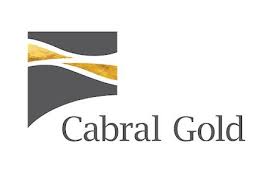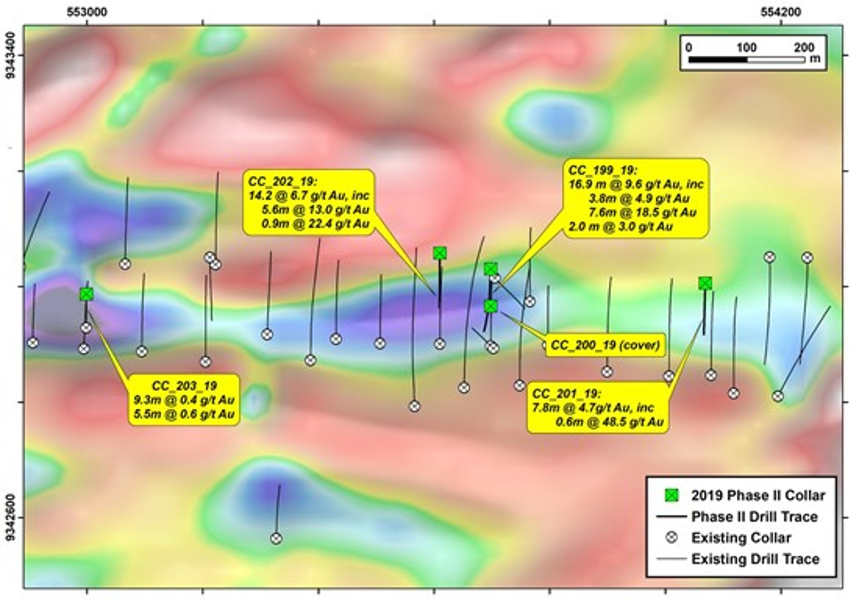
Cabral Drills 5.6m @ 13.0 g/t Gold at Cuiú Cuiú and Confirms Continuity of High-Grade Zones at MG

Cabral Gold Inc. (TSX-V: CBR) is pleased to provide results from an additional four diamond drill holes from the Phase II drilling program at the Cuiú Cuiú Project, which was designed to test the continuity of high-grade zones within the MG (Moreira Gomes) deposit.
Highlights
- Drill hole 202-19 was designed to test the continuity of high-grade mineralization at the MG deposit and returned 14.2m @ 6.7 g/t gold from 109.4m depth including 5.6m @ 13.0 g/t gold from 109.4m and 0.9m @ 22.4 g/t gold from 121.3m depth
- Drill hole 202-19 was drilled 50m west of hole 199-19 which recently returned 16.9m @ 9.6 g/t gold including 7.6m @ 18.5 g/t gold and also tested the up-dip continuity of mineralization previously intersected in hole 50-09 which had returned 35m @ 2.0 g/t gold including 0.5m @ 13.5 g/t and 1.1m @ 6.6g//t gold
- Drill hole 201-19 intersected 7.8m @ 4.7 g/t gold including 0.6m @ 48.5 g/t gold. It was designed to test the up-dip continuity of high-grade mineralization encountered in the eastern-most high-grade target within the MG deposit, above historic hole 79-10, which returned 16.8m @ 5.0 g/t gold including 1.0m @ 56.0 g/t gold and 1m @ 11.6 g/t gold
- These Phase II drill results confirm that the high-grade gold mineralization is continuous down-dip and along strike in at least two of three high-grade zones tested in the recent Phase II program at MG
Alan Carter, President & CEO stated:“These recent drill results from the MG deposit confirm our hypothesis that extensive low-grade mineralization at Cuiú Cuiú surrounds high-grade gold mineralization which is continuous down-dip and along strike in several areas. This represents a step change in our understanding regarding the distribution of gold mineralization and may explain why Cuiú Cuiú produced so much placer gold during the Tapajos gold rush from 1978 to 1995.”
Background
Gold mineralization at Cuiú Cuiú occurs within broad deformed and altered mineralized corridors within granitic rocks. Within these broad zones, distinctive, narrower higher-grade structural zones occur. Historic drill programs completed between 2008 and 2012 were designed to identify bulk-tonnage resources amenable to large-scale open-pit exploitation. As a result, very little attention was directed towards following up the many higher-grade intervals encountered in those programs (of the 180 historic holes completed from 2008 – 2012, a total of 60 intercepts returned values of +10 g/t gold (see press release dated April 29, 2019).
At MG, historic drilling was widely spaced with most of the sections having only one drill hole. However, high-grade mineralization was encountered in drill holes on these sections from surface to vertical depths of 322m below surface. With the very wide spacing of intercepts, high-grade domains could not be correlated with confidence. As a result, the most recent resource estimate for Cuiú Cuiú was adversely impacted by top-end cutting (see press release dated June 7, 2018). The Phase II program was designed to demonstrate the continuity of historic high-grade intercepts (see press release dated February 28, 2019). The objective is to work towards generating a revised resource with better constraints on the high-grade trends.
Phase II Drill Results from MG (Moreira Gomes)
Five diamond drill holes (199-19 to 203-19) were completed at the MG deposit as part of the Phase II drill campaign and were designed to target three potential zones of high-grade gold mineralization (Figure 1) which had been identified in previous drilling. All assay results have now been received from these new holes at MG (see Table 1).

Figure 1: Map showing location of recently completed drill holes (199-19, 200-19, 201-19, 202-19 and 203-19) at the MG deposit at Cuiú Cuiú
Assay results for hole 199-19 (see press release dated 7th November 2019) returned 16.9m @ 9.5 g/t gold from 82.6m, including 7.6m @ 18.5 g/t gold from 91.9m. It was designed to test the up-dip continuity of mineralization cut by a 2010 drill hole, DDH 69-10, which returned 15.8m @ 8.2 g/t gold (including 2.0m @ 53.9 g/t gold) within the centrally located target at MG.
Drill hole 202-19 was drilled 50m west of hole 199-19 within the centrally located high-grade target (Figure 1) and returned 14.2m @ 6.7 g/t gold from 109.4m depth including 5.6m @ 13.0 g/t gold from 109.4m and 0.9m @ 22.4 g/t gold from 121.3m depth (Table 1). The hole was designed to test the up-dip continuity of gold mineralization previously intersected in a 2009 hole (50-09) which returned 35m @ 2.0 g/t gold including 0.5m @ 13.5 g/t and 1.1m @ 6.6g//t gold (see Figure 2). This follow-up hole suggests the presence of a wide high-grade mineralized zone that is continuous along strike and down-dip.
| Hole | Interval | From | To | Interval | Grade | ||
| number | m | m | m | g/t | |||
| CC_199_19 | Upper Mineralized Zone | 82.6 | 99.5 | 16.9 | 9.6 | ||
| including | 82.6 | 91.9 | 9.3 | 2.2 | |||
| including | 82.6 | 83.8 | 1.2 | 13.0 | |||
| including | 91.9 | 99.5 | 7.6 | 18.5 | |||
| including | 91.9 | 92.9 | 1.0 | 14.6 | |||
| including | 92.9 | 93.9 | 1.0 | 35.5 | |||
| including | 93.9 | 94.9 | 1.0 | 14.9 | |||
| including | 96.9 | 98.0 | 1.1 | 44.2 | |||
| including | 98.0 | 99.5 | 1.5 | 16.0 | |||
| Lower Mineralized Zone | 110.9 | 115.9 | 5.0 | 1.5 | |||
| including | 110.9 | 111.9 | 1.0 | 5.5 | |||
| CC_201_19 | Mineralized Zone | 131.0 | 138.8 | 7.8 | 4.7 | ||
| including | 131.0 | 131.6 | 0.6 | 48.5 | |||
| CC_202_19 | Mineralized Zone | 109.4 | 123.6 | 14.2 | 6.7 | ||
| including | 109.4 | 115.0 | 5.6 | 13.0 | |||
| including | 121.3 | 122.2 | 0.9 | 22.4 | |||
| CC_203_19 | Upper Mineralized Zone | 13.0 | 22.3 | 9.3 | 0.4 | ||
| Lower Mineralized Zone | 44.5 | 50.0 | 5.5 | 0.6 | |||
Table 1: Primary basement mineralization intersected in Phase II drilling program
Hole 200-19 was terminated at 50m depth and was designed to intersect the near surface up-dip expression of the high-grade intercept in 199-19 but encountered thicker than expected transported overburden.
Hole 201-19 was drilled 350m east of hole 199-19 (Figure 1) in the easternmost high-grade target at MG where previous drilling had also encountered high-grade gold mineralization. Hole 79-10 intersected 16.8m @ 5g/t gold including 1m @ 56.0 g/t gold. Hole 201-19 intersected the same high-grade zone approximately 50m up-dip and returned 17.8m @ 2.2g/t gold from 122.6m depth, including 7.8m @ 4.7 g/t gold from 131.0m depth (Table 1), confirming the down-dip continuity of high-grade gold mineralization in the eastern-most high-grade target (Figure 3).
Hole 203-19 was drilled in the western-most target at MG (Figure 1) to test the up-dip extension of high-grade gold mineralization (15m @ 16.9 g/t gold) previously returned from hole 53-09. The hole also intersected transported overburden in the area of the projected up-dip extension of the high-grade zone and returned only low-grade values including 9.3m @ 0.4 g/t gold from 13m depth and 5.5m @ 0.6 g/t gold from 44.5m depth (Table 1).

Figure 2: Cross-section showing location of holes 50-10 and 202-19 at the central high-grade target at MG

Figure 3: Cross-section showing location of holes 79-10 and 201-19 at the eastern-most high-grade target at MG
Additional drill results from the Phase II drilling program are expected to be released later this month and will include results from drill holes 204-19 to 206-19, all of which were drilled at the Central deposit and were also designed to follow up historic high-grade drill intercepts.
About Cabral Gold Inc.
The Company is a junior resource company and is engaged in the identification, exploration and development of mineral properties, with a primary focus on gold properties located in Brazil. The Company owns the Cuiú Cuiú gold project located in the Tapajós Region within the state of Pará in northern Brazil.
The Tapajós Gold Province is the site of the largest gold rush in Brazil’s history producing an estimated 30 to 50 million ounces of placer gold between 1978 and 1995. Cuiú Cuiú was the largest garimpo in the Tapajós and produced an estimate 2Moz of placer gold historically.
MORE or "UNCATEGORIZED"
Rupert Resources Reports Results From Project Drilling Including 120m at 6.2g/t Gold
Rupert Resources Ltd. (TSX:RUP) reports assay results from projec... READ MORE
West Red Lake Gold Announces Closing $33 Million Bought Deal Public Offering Including the Full Exercise of the Over-Allotment Option
West Red Lake Gold Mines Ltd. (TSX-V: WRLG) (OTCQB: WRLGF) is ple... READ MORE
Abitibi Metals Drills 13.15 Metres At 4.82% CuEq in Eastern Drilling At The B26 Deposit
Highlights: The Company has received results from drillholes 1274... READ MORE
Patriot Drills 122.5 m at 1.42% Li2O and 71.4 m at 1.57% Li2O at CV5
Highlights Continued strong lithium mineralization over wide inte... READ MORE
Argonaut Gold Announces First Quarter Financial and Operating Results
Argonaut Gold Inc. (TSX: AR) reported financial and operating res... READ MORE










